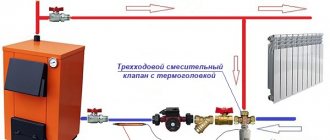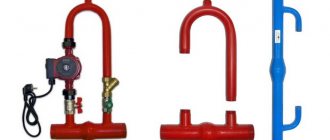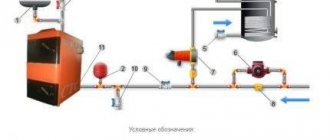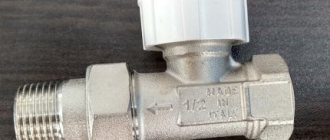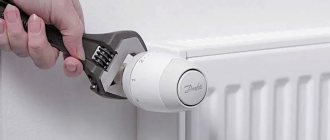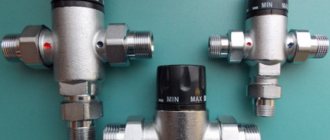A three-way valve with a thermostat for heating is an important part of the room heating control system. The function of the valve is to maintain a comfortable thermal balance throughout the entire room by adjusting the temperature of the coolant in the heating circuit. The three-way valve does not reduce the flow of the working medium, but mixes several flows into one, thereby giving it the set temperature. Another purpose of a three-way valve is to distribute coolant across different circuits. So, heating radiators should receive water of one temperature, and the temperature of the coolant in the “warm floor” system should be different.
Three-way valve device
Structurally, it consists of two connected two-way valves in one body. But unlike them, the hot water flow is not completely blocked, but the intensity of its passage is regulated. Due to this, the temperature of the hot water changes.
- Valve main parts:
- frame;
- rod with locking washer or metal ball;
- fastening nuts (couplings).
Valves with a stem allow automated control via an electromechanical drive. This allows you to automatically regulate the water temperature. The principle of operation of a ball valve can be compared to a kitchen faucet. They are used only in manually operated valves.
Please note: when choosing a faucet, you should pay attention to the material from which the body is made. Brass is lighter and more durable compared to cast iron.
To understand what the thermo-mixing three-way valve of the most common saddle type consists of and how it works, you should study the diagram below.
Inside the brass body with three nozzles, 3 chambers are arranged using the casting method, the passages between which are blocked by poppet valves. They are fixed on one axis - a rod coming out of the body on the fourth side.
Types of Thermostatic Mixing Valves
- They differ in the way they are controlled. Valves can be roughly divided into:
- with manual control;
- with thermal head;
- with electric drive;
- hydraulic;
- pneumatic.
In a private home, an electric valve would be most acceptable. Sensors installed inside issue a command through the controller to the drive if the controlled water parameters change.
As a result, it becomes warmer, or vice versa, cooler. The thermo-mixing effect occurs automatically. It does not matter which boiler is installed in the system - gas or solid fuel.
If it is not possible to install an adjustable valve in the heating system, then the best solution in this case would be a valve with a thermal head.
Advantages and disadvantages
Advantages of three-way mixing valves:
- Simple design.
- Stable regulation.
- Reliability.
- Tightness.
- Sufficient adjustment accuracy (maximum accuracy – up to 1°C).
- Durability.
- Relatively compact dimensions.
The biggest advantage of using three-way valves is that the pipelines and, accordingly, the screed and floor covering do not overheat, which prevents premature failure of the screed and coating.
Flaws:
- The hydraulic resistance of three-way designs is higher than that of a conventional two-way valve.
- The design of the body and spool allows for the presence of stagnant zones - periodically you will have to dismantle the device and clean it of scale, debris, and organic impurities.
- Insufficient accuracy of room temperature control. The control valve quite accurately regulates only the temperature of the outlet coolant, and the temperature of the heated room - approximately.
To ensure a comfortable level of heating, you will have to select the ratio of the temperature of the outlet flow and the temperature in the room “at random”. Unfortunately, the underfloor heating pipelines are much larger than the radiator, and it is impossible to ensure accurate adjustment. The situation is further complicated by the inertia of the heated floor - a 100-mm cement screed warms up very slowly.
But if you are stoic about slowly heating or cooling a room, then a valve with mechanical adjustment is quite suitable for use in the heating system of a private house or apartment.
Installing a three-way valve in a heating system
The thermostatic mixer is installed in the heating system in the mixing unit with single or multi-circuit heat distribution. There may be several such circuits. The schematic diagram will not change. Only new elements will be added.
For example, a mixing unit. The presence of an additional coolant distribution circuit is its main distinguishing feature. Why is it needed? For connecting additional heat consumers. For example, heated floors.
When performing installation work to install the valve, you must remember that it is installed in front of the system pump. The performance of the entire system depends on compliance with this requirement.
When cutting into the valve, you need to make sure that welding waste (slag, drops of molten metal) does not get into it. It is also necessary to provide for the possibility of easy removal of the valve during its operation. This action will be required when periodically checking its performance.
Selecting a three-way valve for heating
To choose the right valve, you need to take into account many different nuances.
- First of all:
- number of circuits in the heating system;
- design feature of valve control;
- inlet pipe diameter;
- throughput of heating system pipelines;
- the material from which the valve is made.
It’s easy to figure out the number of heating system circuits yourself. With other moments of choice, everything is much more complicated. To find out how a three-way valve works and works, just delve into this issue.
And in order to correctly determine even its dimensions, it is necessary to have a concept in thermodynamics.
At its core, a 3-way valve is a valve with a thermostatic head. With an automated control drive, it is able to distribute hot water flows in the desired direction and in the required quantity.
Valves are not able to cope with such a task, which indicates the need for a three-way valve in the heating system. Using a valve in the system, there is no need to come up with some kind of remote control panel to control it. Everything is done without human intervention.
Areas of application
The three-way valve, the operating principle of which was discussed above, has a fairly wide range of applications.
Thus, its varieties, such as an electromagnetic device or a device with a thermal head, are often found in modern pipelines, where it is necessary to adjust the proportions when mixing two separated liquid streams, but without reducing power or volume. As for household use, the most popular here is considered to be a thermostatic mixing device, with which, as noted above, you can regulate the temperature of the working fluid. This liquid can be supplied both to the “warm floor” pipeline and to heating radiators. And if the valve also has automatic control, then you can control the temperature in your home without any problems!
Note! The use of a three-way valve in a heating system to balance temperature changes is extremely beneficial not only in terms of comfort and convenience, but also in terms of cost savings. The fact is that by regulating the temperature of the liquid at the “return” of the heating device, you can significantly reduce the volume of fuel consumed, and this will have a positive effect on the efficiency of the system itself
In some systems, a valve is simply necessary. For example, in a “warm floor” system, this device prevents overheating of the floor covering above a given comfort level, thereby relieving users of unpleasant sensations
The fact is that by regulating the temperature of the liquid at the “return” of the heating device, you can significantly reduce the volume of fuel consumed, and this will have a positive effect on the efficiency of the system itself. In some systems, a valve is simply necessary. For example, in a “warm floor” system, this device prevents overheating of the floor covering above a given comfort level, thereby relieving users of unpleasant sensations.
Regulating devices of this kind are also used in water supply systems in order to obtain a permanent flow at the required temperature. The simplest example is an ordinary mixer, in which you can make water hotter/cooler by opening/closing a cold tap.
Safety valve for boiler
Previously, we described how to select and connect a safety valve for a boiler, talked about its areas of application and internal structure. In addition to this article, we recommend that you read: all the details here
How does a three-way valve work in a heating system?
The principle of operation of the valve is to mix water flows with different temperatures. Why do you need to do this? Without going into technical details, we can answer this way: to extend the life of the heating boiler and make it more economical.
A three-way valve mixes heated water with cooled water after passing through the heating devices and directs it back to the boiler for heating. Everyone can answer the question of which water to heat faster and easier - cold or hot.
Simultaneously with mixing, the valve also separates the flows. There is a natural desire to automate the management process itself. For this purpose, the valve is equipped with a temperature sensor with a thermostat. In this case, an electric drive works best here. The quality of functioning of the entire heating system depends on the drive device.
- Such a valve is installed in those places of the pipeline where it is necessary to split the circulation flow into two circuits:
- With constant hydraulic mode.
- With variable.
Typically, a constant hydraulic flow is used by consumers who are supplied with a high-quality coolant of a certain volume. It is regulated depending on quality indicators.
Variable flow is consumed by those objects for which quality indicators are not the main ones. The quantitative coefficient is important to them. That is, for them the supply is adjusted according to the required amount of coolant.
There are also two-way analogues in the shut-off valves category. What is the difference between these two types? The three-way valve works completely differently. In its design, the rod cannot block the flow with a constant hydraulic regime.
It is always open and adjusted to a certain volume of coolant. This means that consumers will receive the required amount in both quantitative and qualitative terms.
Essentially, the valve cannot shut off the supply to a circuit with constant hydraulic flow. But it is capable of blocking a variable direction, thereby allowing you to regulate pressure and flow.
If you combine two two-way valves, you get a three-way design. In this case, both valves must operate reversibly, that is, when the first one closes, the second one must open.
Types of three-way valves according to operating principle
- According to the principle of action, this type is divided into two subtypes:
- Mixing.
- Separating.
Just by the name you can understand how each type works. The mixer has one output and two inputs. That is, it performs the function of mixing two flows, which is necessary to lower the temperature of the coolant. By the way, this is an ideal device for creating the desired temperature in underfloor heating systems.
Regulating the temperature of the exhaust ceiling is quite simple. To do this, you need to know the temperature of the two incoming streams and accurately calculate the proportions of each in order to obtain the required temperature regime at the output. By the way, this type of device, if installed and adjusted correctly, can also work on the principle of flow separation.
A three-way separation valve splits the main flow into two. Therefore, it has two outputs and one input. This device is commonly used to separate hot water in hot water systems. Experts often install it in air heater trims.
In appearance, both devices are no different from each other. But if you look at their cross-sectional drawing, there is one difference that immediately catches your eye. The mixing device has a rod with one ball valve.
It is located in the center and covers the saddle of the main passage. In a separating valve there are two of these valves on one stem, and they are installed in the outlet pipes. The principle of their operation is as follows: the first closes one passage, pressing against the saddle, and the second at this time opens another passage.
- Modern three-way valves are divided into two types according to the control method:
- Manual.
- Electric.
More often you have to deal with a manual version, which is similar to a regular ball valve, only with three pipes - outlets. Electrical automatic systems are most often used for heat distribution in private housing construction.
For example, you can adjust the temperature in the rooms, distributing the coolant depending on the distance of the room from the heating boiler. Or ensure combination with a heated floor system. Devices with large cross-country ability are installed on heat pipelines between buildings.
Like any device, a three-way valve is determined by the diameter of the supply pipe and the coolant pressure. Hence GOST, which allows for certification. Failure to comply with GOST is a serious violation, especially when it comes to pressure inside the pipeline.
Brief overview of three-way valve manufacturers
There are many companies that produce such equipment, but three of them are the most popular - Esbe, Navien and Danfoss. It is these brands that we will talk about today. Along the way, we will also learn about the opinions of network users who have installed similar faucets in apartments or private houses.
Three-way valves "Esbe" with electric drive
Thermostatic valve "Esbe" - time-tested reliability.
The model "ESBE VRG131" is interesting. Let's take a closer look at it. On store shelves it is found only with manual adjustment, but no one bothers to install an automatic one instead of the handle.
Technical characteristics of "ESBE VRG131" in comparison with "ESBE VTA522"
| Model | Working pressure, bar | Max t, °С | Thread diameter, inch | Throughput, m3/h |
| ESBE VRG131 | 10 | 110 | 3/4 | 6.3 |
| ESBE VTA522 | 10 | 95 | 1 | 3.2 |
"Navien": Korean-assembled equipment
It so happens that Korean goods are always of high quality. This statement applies to any technology as long as it is not counterfeited. Those who respect their reputation monitor all technological processes. And the low cost is due precisely to the fact that production in China is cheaper than in other countries.
Three-way valve "Navien" comes from Korea
The cost of Navien three-way valves is lower than that of the previous brand, but this does not mean that they are worse. Psychology plays a role here. The manufacturing company is less known, which means the markup on the brand is lower.
Danfoss three-way valves and their features
Given the high quality of the equipment produced, experts warn the consumer that their devices cannot be lubricated with mineral or semi-synthetic oils. Only synthetics are allowed to be used. There are also high demands on the quality of the coolant. In case of violation of operating conditions, the manufacturer declines all responsibility.
Equipment for heating systems,
For example, let's look at models produced by Danfoss - RTR-N 15 UK and RA-NCX.
| Model | Working pressure, bar | Max t, °С | Thread diameter, inch | Throughput, m3/h |
| RTR-N 15 UK | 10 | 90 | 1/2 | 0.9 |
| RA-NCX | 10 | 100 | 1/2 | 1 |
As you can see, the devices are almost identical, but the cost of “RTR-N 15 UK” is 1800 rubles, and the price of “RA-NCX” is 2200 rubles (prices are indicated as of January 2022).
However, there are plenty of other worthy manufacturers on Russian shelves. Let's try to summarize the information about their models in tabular form.
It happens that the thermostat comes complete with a heating radiator when purchasing
Diagram of a heated floor with a three-way valve
Once you have an understanding of what a three-way valve is and what its work is, you can consider various connection diagrams, depending on the purpose and role of the element in heating the house.
- Thermal mixing valve is installed in the following cases:
- To protect a solid fuel boiler from the effects of condensation and temperature shock after sudden power outages.
- The coolant in the underfloor heating circuits should warm up to no more than 45 °C, which is ensured by a mixing unit with a three-way valve.
- To maintain the required coolant temperature in different places of the system.
- To protect a solid fuel heating unit from the formation of condensation, it is impossible to allow cooled water from the radiator network to be supplied to the boiler tank during its heating.
To do this, use the following boiler connection diagram with a bypass and a three-way mixing valve:
The scheme works like this. Until the heat generator warms up, water circulates in a small circle through the bypass. When the coolant in the return heats up to 50-55 °C, the valve begins to open and mix in cold coolant from the system. When the heater reaches operating mode, the bypass is closed and the entire flow goes through the radiators.
In a heated floor system, this element performs the same functions. The circulation pump circulates the coolant through the heating circuits until it begins to cool. As soon as this happens, the sensor and thermal head will operate, after which the three-way valve will begin to add hot water coming from the boiler to the closed circuit.
How to correctly install a heated floor manifold, pump and valve with your own hands is shown in the diagram:
The next example of the use and connection of this important part is the connection between a solid fuel heat generator and a buffer tank, which is a heat accumulator.
To warm it up completely quickly enough, the temperature of the supplied coolant must be from 70 to 85 ° C, which is not at all necessary in a radiator heating system. A three-way valve installed behind the container along with a separate circulation pump helps to lower it.
Important. When installing the mixing valve, remember that the pump should be located on the side where the three-way valve is always open.
A complex heating system of a large cottage can have many consumers connected via a hydraulic valve and a distribution manifold.
Moreover, coolant with a different temperature must be supplied to each of the circuits. The highest is needed for an indirect heating boiler, so there are no control valves on the supply line to it. The remaining consumers need a colder coolant, and therefore they are connected through three-way valves.
- Depending on the direction of flow, the thermostatic valve is available in two models:
- T-shaped or symmetrical design. With this connection, hot and cold water enters through the side holes, and after mixing, the liquid flows out through the central passage.
- L-shaped or asymmetrical design. In this case, hot water comes from one side, and cold water from below. Subsequently, the mixed flow exits from the second side passage.
Wiring diagram for a three-way mixing valve.
A mixing valve equipped with a thermostat is installed if it is necessary to ensure a stable temperature of the coolant.
- Considering the mixing unit, we can distinguish the following components in it:
- Check Valve;
- temperature sensor;
- circulation pump;
- three-way mixing valve.
Diagram of a mixing unit for heated floors
The connection diagram includes a circulation pump mounted on the supply. Then a temperature sensor is installed, which is necessary to determine the degree of heating of the incoming water.
After this comes the thermostatic valve. A check valve with an outlet is mounted on the “return”, which is connected to a pipe with circulating cooled liquid directed to the mixing valve.
- With a similar connection diagram, the coolant moves along the following route:
- Pumping hot water using a circulation pump into the equipped heated floor system. The coolant temperature can reach 80°C.
- Mixing with cold water through a three-way valve. As a result, the desired temperature is achieved.
- Distribution of coolant through underfloor heating pipes.
- The return of the cooled water to the “return”, from where it is taken into the three-way valve for subsequent mixing with the hot liquid.
With such a connection, the temperature sensor regulates the degree of heating of the water entering the water circuit. There are other ways to control. The most ineffective is the manual method, when you need to change the flow by turning the handle.
There is a control option using a servo drive, commands to which are received from the controller in accordance with signals received from sensors.
Diagram of components based on three-way mixing and thermostatic valves for heated floors.
The thermostatic tap plays an important role when installing a water heated floor. By preventing the coolant entering the pipes from overheating, it saves fuel. In addition, safety is ensured during the operation of a rather complex heating system and the trouble-free service life is extended.
Installation diagram of a three-way separating valve
Provides quantitative control for the consumer - by changing the coolant flow. It is used if, according to the operating conditions of the heat source, it is permissible to bypass the coolant into the return pipeline and it is not allowed to stop circulation in the source circuit.
This scheme for installing a three-way valve has been widely used in water and air heating units connected from an autonomous boiler room. To link hydraulic circuits, the pressure loss at the balancing valve in the bypass line must be equal to the pressure loss at the consumer.
This installation diagram for a three-way valve is intended for connection to a pipeline with excess pressure. The coolant circulation in the consumer circuit is ensured due to the excess pressure created by the circulation pump in the heat source circuit.
Installation diagram of a three-way separating valve
Schemes for installing a three-way mixing valve for separation
Provides quantitative control at the consumer using a three-way mixing valve. It is used if, according to operating conditions, cessation of flow in the source circuit is not allowed, but the bypass of coolant from the supply pipeline to the return pipeline is acceptable.
Similar schemes for connecting three-way valves have become widespread in the piping of air heaters and air coolers, as well as in water heating units installed in autonomous boiler houses.
It is recommended to install a balancing valve with a hydraulic resistance equal to the consumer resistance on the mixing pipe of the three-way valve. Circulation through the consumer and bypass is carried out due to excess pressure in the source circuit.
With the correct selection of the valve and hydraulic coupling of the bypass with the consumer circuit, the flow through the heat source is constant, and in the consumer circuit it is variable.
Connection diagram of a three-way mixing valve for flow separation to a pressure manifold
Since the water flow moves in the opposite direction to the direction of flow in the mixing valve, some valves may increase noise and vibration, as well as reduce the permissible pressure drop across the valve.
Installation diagram of a three-way mixing valve for separation to a hydraulic arrow When connecting a unit with a three-way separation valve to a heat source directly or to a free-flow collector, it is necessary to install a circulation pump in the supply or return pipeline. The pump can be common to several circuits.
The connection diagram of a three-way valve dividing the flow with an additional bypass in the consumer circuit parallel to the mixing line is used provided that the temperature regime of the source exceeds the temperature regime of the consumer.
The peculiarity of this scheme is that the flow rates in the source and consumer circuits will be constant, and overheated coolant will not flow to the consumer. The consumer will be provided with quality regulation. For this circuit to work, it is necessary to install a pump in the consumer circuit and in the source circuit.
If gas is available, the most economical way to heat a private home is a double-circuit gas boiler.
Or, as an option, an electric boiler.
Operating principle and types of valve actuators
The product is produced in different configurations and with different drives, but the principle of operation of the three-way valve remains unchanged: mix two flows with different temperatures into one, the temperature of which is specified by the user or required by the scheme. The liquid inside the valve flows from one pipe to another until its temperature changes and reaches the set value. Then the drive gradually opens the flow from the third pipe, keeping the temperature of the leaving water within the set value. On this basis, such a valve is called a three-way valve.
Operating principle of three-way valve
Any three-way mixing valve has two inlets and one outlet. Flow distribution is carried out using a drive, which comes in several types:
- The thermostatic drive (thermostat) is one of the most popular; it works due to the thermal expansion of the sensing element, as a result of which pressure is placed on the valve stem and the liquid begins to mix.
- A widely used type of drive that is installed in a three-way changeover valve is electric, operating from a signal from the control unit.
- The valve can be controlled by pressing the stem using a thermostatic head drive. It reacts to the air temperature, which it determines itself or using a remote sensor and a capillary tube. The drive is most often used in underfloor heating systems.
Stationary solid fuel boilers cannot be directly included in the heating system. One of the reasons is to prevent cold water from entering the boiler jacket until it has warmed up. Otherwise, condensation is released on the walls of the firebox, which, mixing with ash, forms a durable layer of soot. It interferes with free heat exchange, reducing the efficiency of the installation, and it is very difficult to clean off carbon deposits. The second reason is that cast iron fireboxes need to be protected from temperature changes in the event of an unexpected pump stop due to a power outage, and then its restart. The task is to prevent cold water from entering the hot boiler, which is why a three-way valve is needed. He will force the coolant to circulate in a small circle until it warms up, and only then will he begin to mix in cold water.
Three-way mixing valve with thermal head
The valve with thermostat guarantees the practicality and efficiency of the system. Three-way heating valves are designed to regulate heat flow, which ensures indoor comfort and economical use.
Before proceeding with the design of the heating system, a thermal calculation is performed. Based on its results, the appropriate power and type of heating devices are selected that can maintain the optimal temperature in the room.
The area of the room is taken into account, and then possible heat losses are analyzed. Based on this, the performance of the heating system necessary to create a comfortable microclimate in the rooms is calculated. After that, a heat balance is compiled for all rooms.
However, these calculations are made under specific conditions, which may change during operation.
- The factors affecting the operation of the radiator are different:
- temperature changes outside;
- solar Activity;
- wind force;
- the presence of household appliances that generate heat.
As a result, the calculated temperature balance is disrupted and the room becomes hot. However, it is impossible to remove parts of the radiator from the room or muffle thermal radiation. Thus, there is a need to manage the energy generated by heating devices in order to maintain a comfortable microclimate in the room.
- There are two ways to regulate the energy released by the radiator:
- Qualitative change in the properties of the radiator.
- Quantitative regulation of heat generated.
- In both cases, manipulations with the liquid circulating through the pipes are necessary.
In cases where you cannot influence the temperature of the water supplied to the radiator, you can regulate its quantity. For this you need to buy three-way valves for heating with a thermostat.
These devices make it possible to limit the amount of water passing through the radiator, and as a result, with the same radiator area, more or less heat will flow into the room, of course, within limits limited by the power of the system.
Three-way mixing valve with thermostat
A three-way valve for the heating system and a temperature controller installed on the radiator can be used separately, however, in autonomous heating systems of modern apartments and private cottages, a combined method is often used to increase efficiency.
Thus, it is advisable to purchase a three-way valve for heating with a thermostat.
It is important to consider that the operating principle of a three-way mixing valve allows you to increase or decrease the radiator temperature only within established limits. These limits are dictated by the technical characteristics of the heating device, namely, the value of its maximum heat transfer, and depend on each specific radiator.
Areas of application
Modern valves are in wide demand and are actively used in various areas of human activity. They are often installed in modern heating mains, which require constant adjustment of proportions when mixing different coolant flows. For such purposes, it is customary to use electromagnetic devices or models with a thermal head.
As for domestic use, in this case it is enough to purchase a thermostatic mixing device that will allow you to regulate the temperature of the coolant. It is supplied both to the underfloor heating piping system and to heating radiators. And if the household device is equipped with automatic control, then changing the temperature in the room will be much easier.
The use of a three-way valve in a heating system is profitable and economical
It should be noted that using a tee in a heating system to balance possible temperature surges is not only beneficial, but also economical. The device allows you to reduce the volume of fuel consumed several times, while the final efficiency indicators of the system will increase noticeably. In some rooms, the presence of such a device is simply necessary. For example, if a heated floor is installed in the house, then the device will prevent excessive heating of the floor covering.
Servo drive for three way valve
A servo is an electric motor controlled through negative feedback. In this case, the negative feedback will be a shaft angle sensor, which stops the shaft movement when the desired angle is reached.
For clarity, let’s look at the servo drive device according to the figure:
- As you can see, the following components are located inside the servo drive:
- Electric motor.
- A gearbox consisting of several gears.
- The output shaft by which an actuator rotates a valve or other device.
- The potentiometer is the same negative feedback that controls the angle of rotation of the shaft.
- Control electronics, which is located on the printed circuit board.
- The wire through which the supply voltage (220 or 24 V) and the control signal are supplied.
Let's now take a closer look at the control signal. The servo drive is controlled by a pulse signal with variable pulse width. For those who don’t know what we’re talking about, here’s another picture:
That is, the pulse width (in time) determines the magnitude of the shaft rotation angle. Setting up such control signals is not trivial and depends on the specific drive. The number of control signals depends on how many positions the output shaft can occupy.
The servo drive can be two-position (2 control signals), three-position (3 control signals) and so on.





